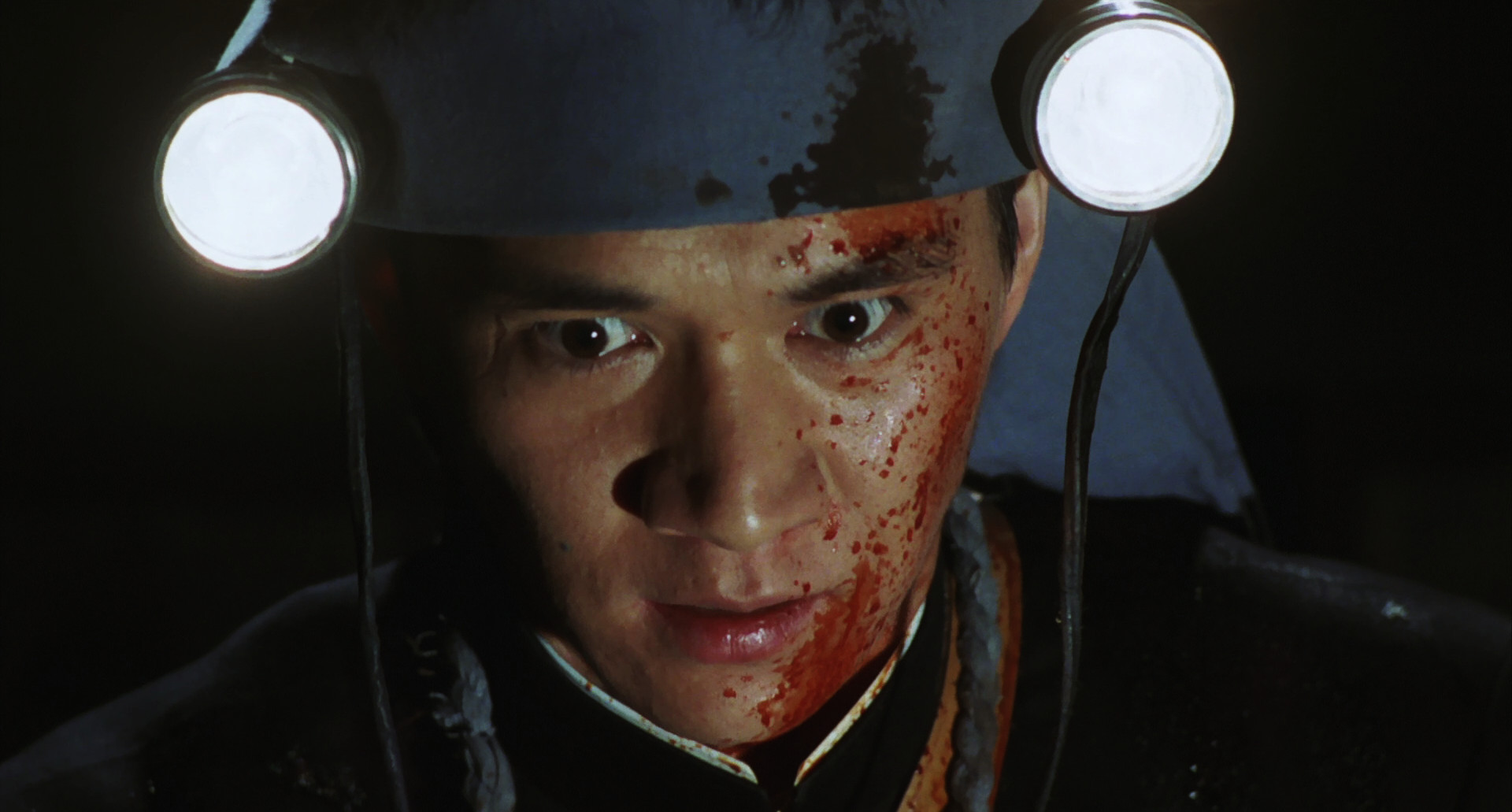This article was originally published at Eiga-Bouei, a short-lived Japanese cinema project of mine that has long-since bit the dust. It is republished here, with minimal alterations, to coincide with Unearthed Films’ announcement of Village of Doom‘s North American blu-ray debut.
Young Tsugio INUMARU (Masato FURUOYA) is a perennial invalid, and something of a pariah in his rural village. It’s the late 1930s, and at a time when the rest of the village’s young men have been enlisted into the Imperial Army the sickly Tsugio is safe at home with his only family – a doting grandmother. Tsugio’s self-education and perceived arrogance only complicates his relationship with his fellow villagers further, isolating him from all but Yasuyo (Misako TANAKA), a young woman his own age whom Tsugio adores. But Tsugio’s relationship with Yasuyo is emotionally fumbling and physically unconsummated, a point of frustration for a young man in the throws of sexual development. Complicating things further is Tsugio’s stringent nationalism, which defines his social interactions and finds him constantly and inevitably falling short of his own expectations.
An unexpected outlet for the young man’s frustrations arises within the village’s female population, particularly those whose young husbands are at war. Several of the wives contrive clandestine relationships with the weak (and presumed harmless) Tsugio, whom they find a convenient tool for alleviating their own loneliness. Tsugio wastes little time in adapting to his new lot in life, but the charm of it all is short-lived. Determined to serve his country along with the rest of his generation, Tsugio subjects himself to a physical examination so that he might enlist in the army as well. The results are disastrous. The cause of the young man’s ongoing illness is tuberculosis, an incurable disease in Tsugio’s time and one which had claimed both of his parents years before.
Word of the diagnosis travels quickly, and Tsugio finds himself ever more at odds with his fellow villagers. Upon witnessing the brutal murder of a transient misfit by a gang of his elders Tsugio tries to do the right thing, but after reporting the crime to a local authority he is derided and ostracized instead. The women of the village close their doors to him as well, disgusted and fearful of what his disease might mean for them. Only Yasuyo remains in support, but this too is fleeting – when she is ushered off to an arranged marriage by her family Tsugio finds himself alone once more, and his fervency and frustration begins to transform into something far more disturbing. As his rage against his fellow villagers grows Tsugio quietly plots, secretly arming himself for a vengeful assault on all those he believes have wronged him.
Late one evening his plan is put to action. He cuts the electrical lines into the village and returns home, where he ritually transforms himself into something less than human – a do-it-yourself demon with a pump shotgun at his side and a pair of flashlights strapped to his head. As the village sleeps Tsugio descends, systematically eliminating the families he deems to have transgressed against him and finding empowerment and purpose in the bloody destruction of those who had so long denied him.
As shocking a film now as it was upon its release in early 1983, lauded pink film director Noboru TANAKA’s Village of Doom is an unconventional and unsettling exploration of one of present society’s most persistent bogeymen – the mass shooter. If Tsugio’s influences and actions feel disturbingly true to life (especially in a era where the crimes and character of his all-too-common modern analogues are dissected ad nauseam by a voracious 24-hour media cycle) it’s with good reason. Despite altering names and taking a degree of dramatic liberty with the subject matter (as had Nozomi NISHIMURA’s eponymous 1981 source novel) Village of Doom is a broadly accurate retelling of the infamous Tsuyama Incident, which occurred in a rural village in Okayama in May of 1938. Indeed, Village of Doom‘s protracted and controversial reenactment of the event earned it the ire of Japan’s censorship board – the Eirin deemed the film to be unjust and cruel on the whole and restricted it in theatrical release with a rating of R-18, the equivalent of an X from the MPAA.
One can forgive them for finding the film a tactless affair – it is, and deliberately so. Director Tanaka was best known then as now as the talent behind some of the very best of Nikkatsu’s Roman Porno series, and he brought the same transgressive sensibilities to his first (and unless I’m mistaken, only) production for Shochiku. In retrospect Village of Doom seems a logical progression for the studio, which had been going against its own trademark style (and with excellent box office results) since the middle 1970s. Their highly publicized and very successful 1977 adaptation of Seishi YOKOMIZO’s much-loved mystery novel Village of 8 Gravestones thrilled audiences not just with its lofty production value, but with fountainous bloodshed as well. Coincidentally or otherwise, one of that film’s most famous scenes plays as a deliciously grim invocation of the Tsuyama Incident (from which Yokomizo’s novel, which began serialization in 1949, drew contemporary inspiration). Shōhei IMAMURA’s violent biographical drama Vengeance is Mine continued the trend, casting top talent Ken OGATA as an ex-con fraudster who murdered his way across Japan nary a decade prior. That film won praise from critics and audiences alike, topping Kinema Junpo’s top-ten list for the year and sweeping most of its annual awards categories.
There’s a lot of similarity to be had between the Imamura film and Tanaka’s, which premiered four years later, most having to do with the historically-grounded subject matter (whether through intent or by happenstance, Shochiku’s advertising art for both is strikingly similar). Village of Doom separates itself largely along exploitative lines (More sex! More violence!), with Tanaka playing the gruesome eventualities of his story to the outrageous, subversive hilt. Indeed, the enduring shock-factor of the film lies less in its violent content (considerable in a film built around the slaughter of nearly three-dozen people) than in the unexpected manner in which Tanaka portrays it. Despite the true crime overtones Village of Doom plays a lot like some of the other action sagas of the decade, replete with hissable baddies who go against the moral righteousness of a just hero and are summarily suppressed in bloody fashion, with one-liners to spare and a triumphant power ballad to tie everything neatly together.
Of course the hero in this case isn’t an ex super-soldier blackmailed into action or a Vietnam vet pushed too far by prejudiced yokels or Rowdy Roddy Piper laying a smackdown on an alien invasion, he’s a real-life mass murderer responsible for one of the most infamous crimes in Japanese history. To that end Village of Doom seems almost calculated to incense those who rail against violent media as murder fuel for the world’s disgruntled loners, indulging as it does in an almost mythic glorification of an actual atrocity. It’s a coup for director Tanaka, who deftly hijacks established heroic conventions for his own nefarious purposes and leaves audiences in the uncomfortable position of rooting for a man they know will be responsible for terrible things. That so many of Tsugio’s attacks amount to little more than gruesome misogynist wish fulfillment only heightens the internal unease, the viewer’s innate thirst for cinematic justice conflicting with the abject horror of the action unfolding on screen. We can be frightfully permissive just so long as we’re provided a satisfying dénouement, a fact Village of Doom lays bare. Rarely has a film left me feeling so uncomfortable in my own skin.
Credit director Tanaka for that, but also star Masato FURUOYA, whose gaunt, tall physique (he measured a lofty 188 cm, or roughly 6 ft 2 in) was a perfect physical match for the alternately meek and menacing Tsugio. A sometimes collaborator of Tanaka’s and a fellow veteran of Nikkatsu’s Roman Porno revival, Furuoya capably carries the film, which unfolds explicitly from the perspective of his character – without his ability to render Tsugio so sympathetically much of Village of Doom‘s unsettling potential might well have been lost. Though Furuoya necessarily commands the bulk of audience attention Shochiku provide a typically strong stable of familiar talent in his support. Prolific stage, film, and television actor Izumi HARA was already well into the fifth decade of her career by the time of Village of Doom‘s production, and appears here in a hefty role as Tsugio’s grandmother, while Isao NATSUYAGI (Village of 8 Gravestones) is suitably unpleasant as a seedy village headman. Yasuhiro ARAI (Mishima: A Life in Four Chapters) is best known for his extensive and ongoing career in television, and appears as Tsugio’s disaffected loafer buddy Tetsuo – a youth aimlessly biding what time he has left before the army drafts him off to an untimely demise. Misako TANAKA (Roar of the Crowd), Shino IKENAMI (Devil’s Flute), Kumiko OHBA (House), and Midori SATSUKI (Blade of Oedipus) take turns as Tsugio’s varying love interests (his beloved Yasuyo and a trio of ill-fated housewives respectively), and gravure photo shoots of the four in (and to varying degrees out of) costume were a significant component of Shochiku’s promotional push for the film.
While attendance figures are hard to come by it’s safe to say that Shochiku were pleased with Village of Doom‘s performance, and continue to profit from its reputation. The film has been a staple of the company’s Best of… series of video releases since the days of VHS, and was recently reissued in a restored Blu-ray edition. Nothing sells quite like sex, violence, or controversy, and Village of Doom wraps all three into a package that’s far more alluring than most of us would care to admit.

